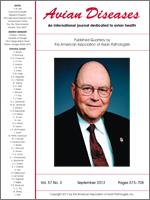This investigation to examine influenza A virus activity in avian species at four Ohio zoos was initiated to better understand the ecology of avian-origin influenza A (AIV) virus in wild aquatic birds and the possibility of spill-over of such viruses into captive zoo birds, both native and foreign species. Virus isolation efforts resulted in the recovery of three low pathogenic (LP) AIV isolates (one H7N3 and two H3N6) from oral-pharyngeal or cloacal swabs collected from over 1000 zoo birds representing 94 species. In addition, 21 LPAIV isolates possessing H3N6, H4N6, or H7N3 subtype combinations were recovered from 627 (3.3%) environmental fecal samples collected from outdoor habitats accessible to zoo and wild birds. Analysis of oral-pharyngeal and cloacal swabs collected from free-ranging mallards (Anas platyrhynchos) live-trapped at one zoo in 2007 resulted in the recovery of 164 LPAIV isolates (48% of samples) representing five HA and six NA subtypes and at least nine HA-NA combinations. The high frequency of isolate recovery is undoubtedly due to the capture and holding of wild ducks in a common pen before relocation. Serologic analyses using an agar gel immune diffusion assay detected antibodies to the influenza A virus type-specific antigen in 147 of 1237 (11.9%) zoo bird sera and in 14 of 154 (9%) wild mallard sera. Additional analyses of a limited number of zoo bird sera demonstrated HA- and NA-inhibition activity to 15 HA and nine NA subtypes. The spectrum of HA antibodies indicate antibody diversity of AIV infecting zoo birds; however, the contribution of heterologous cross-reactions and steric interference was not ruled out. This proactive investigation documented that antigenically diverse LPAIVs were active in all three components of the avian zoologic-wild bird interfaces at Ohio zoos (zoo birds, the environment, and wild birds). The resulting baseline data provides insight and justification for preventive medicine strategies for zoo birds.
Actividad del virus de la influenza A de baja patogenicidad en interfaces aviares en zoológicos de Ohio, 2006–2009.
Se inició esta investigación para examinar la actividad del virus de la influenza A en especies de aves en cuatro zoológicos del estado de Ohio, para comprender mejor la ecología de los virus de la influenza aviar en aves acuáticas silvestres y la posibilidad de la transmisión de estos virus en aves cautivas de zoológicos, tanto para especies nativas o extranjeras. Los esfuerzos de aislamiento del virus resultaron en la recuperación de tres aislamientos del virus de la influenza aviar de baja patogenicidad (uno H7N3 y dos H3N6) a partir de hisopos orofaríngeos o cloacales recolectados de más de 1,000 aves de zoológico que representaban a 94 especies. Además, 21 aislamientos del virus de la influenza aviar de baja patogenicidad de los subtipos H3N6, H4N6, H7N3 fueron recuperados de 627 (3.3%) muestras fecales ambientales recolectadas de hábitats al aire libre accesibles al zoológico y de aves silvestres. El análisis de los hisopos orofaríngeos y cloacales recolectados de patos de collar en libertad (Anas platyrhynchos) atrapados vivos en un zoológico en el año 2007 resultó en la recuperación de 164 aislamientos de influenza aviar de baja patogenicidad (en 48% de las muestras) que representaban a cinco subtipos de HA, a seis subtipos de NA y al menos a nueve combinaciones de HA-NA. Sin duda, la alta frecuencia de aislamientos se debe a la captura y alojamiento temporal de patos silvestres en un corral común antes de la reubicación. Mediante análisis serológicos utilizando el ensayo de inmunodifusión en gel de agar se detectaron anticuerpos específicos contra el virus de influenza tipo A en 147 de los 1237 (11.9%) sueros de aves zoológico y en 14 de 154 (9%) sueros pato de collar silvestre. Los análisis adicionales de un número limita





